bonnet Peugeot 308 CC 2013.5 Owner's Manual - RHD (UK, Australia)
[x] Cancel search | Manufacturer: PEUGEOT, Model Year: 2013.5, Model line: 308 CC, Model: Peugeot 308 CC 2013.5Pages: 268, PDF Size: 16.54 MB
Page 5 of 268
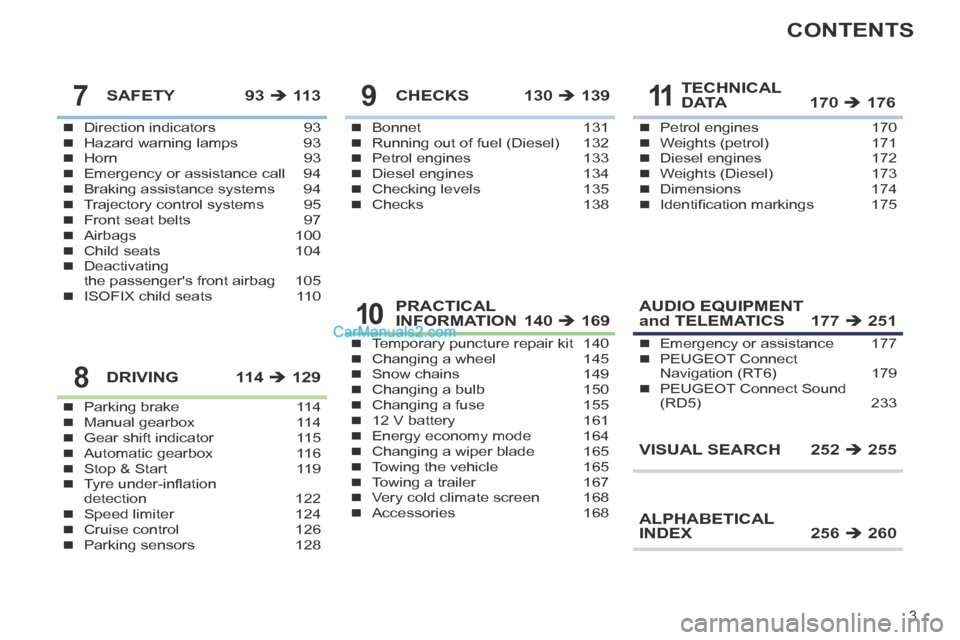
3
CONTENTS
Direction indicators 93Hazard warning lamps 93Horn 93Emergency or assistance call 94Braking assistance systems 94Trajectory control systems 95Front seat belts 97Airbags 100Child seats 104Deactivating the passenger's front airbag 105ISOFIX child seats 110
SAFETY 93 11 3
Parking brake 114Manual gearbox 114Gear shift indicator 115Automatic gearbox 116Stop & Start 119Tyre under-infl ation detection 122Speed limiter 124Cruise control 126Parking sensors 128
DRIVING 114 129
Bonnet 131Running out of fuel (Diesel) 132Petrol engines 133Diesel engines 134Checking levels 135Checks 138
CHECKS 130 139
Temporary puncture repair kit 140Changing a wheel 145Snow chains 149Changing a bulb 150Changing a fuse 15512 V battery 161Energy economy mode 164Changing a wiper blade 165Towing the vehicle 165Towing a trailer 167Very cold climate screen 168Accessories 168
PRACTICAL INFORMATION 140 169
Petrol engines 170Weights (petrol) 171Diesel engines 172Weights (Diesel) 173Dimensions 174Identifi cation markings 175
TECHNICAL D ATA 170 D ATA 170 D ATA 176
AUDIO EQUIPMENT and TELEMATICS 177 251
VISUAL SEARCH 252 255
ALPHABETICAL INDEX 256 260
Emergency or assistance 177PEUGEOT Connect Navigation (RT6) 179PEUGEOT Connect Sound (RD5) 233
7
8
9
10
11
Page 12 of 268
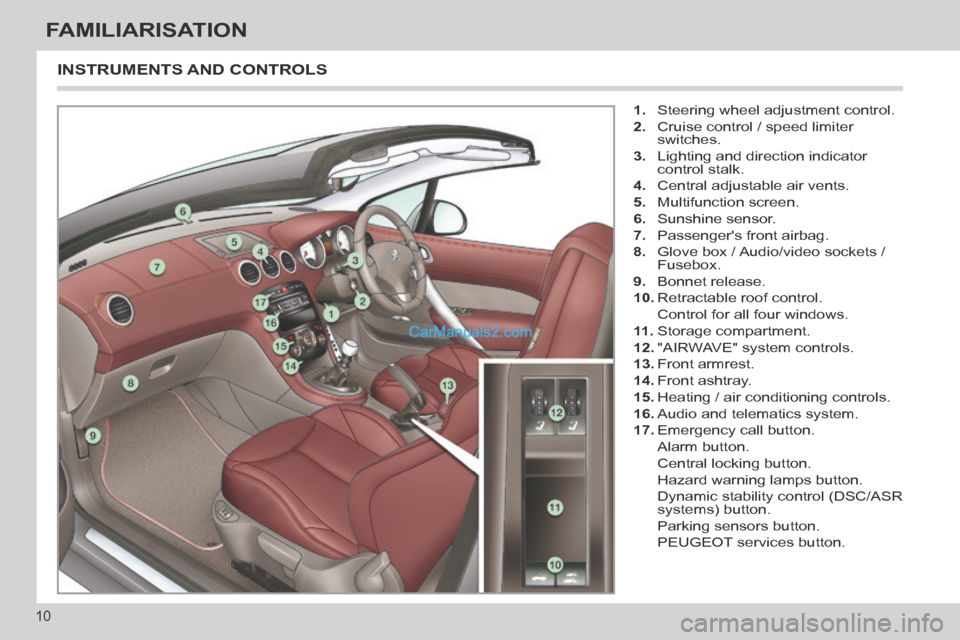
10
FAMILIARISATION
INSTRUMENTS AND CONTROLS
1. Steering wheel adjustment control.
2. Cruise control / speed limiter switches.
3. Lighting and direction indicator control stalk.
4. Central adjustable air vents.
5. Multifunction screen.
6. Sunshine sensor.
7. Passenger's front airbag.
8. Glove box / Audio/video sockets / Fusebox.
9. Bonnet release.
10. Retractable roof control.
Control for all four windows.
11 . Storage compartment.
12. "AIRWAVE" system controls.
13. Front armrest.
14. Front ashtray.
15. Heating / air conditioning controls.
16. Audio and telematics system.
17. Emergency call button.
Alarm button.
Central locking button.
Hazard warning lamps button.
Dynamic stability control (DSC/ASR systems) button.
Parking sensors button.
PEUGEOT services button.
Page 19 of 268
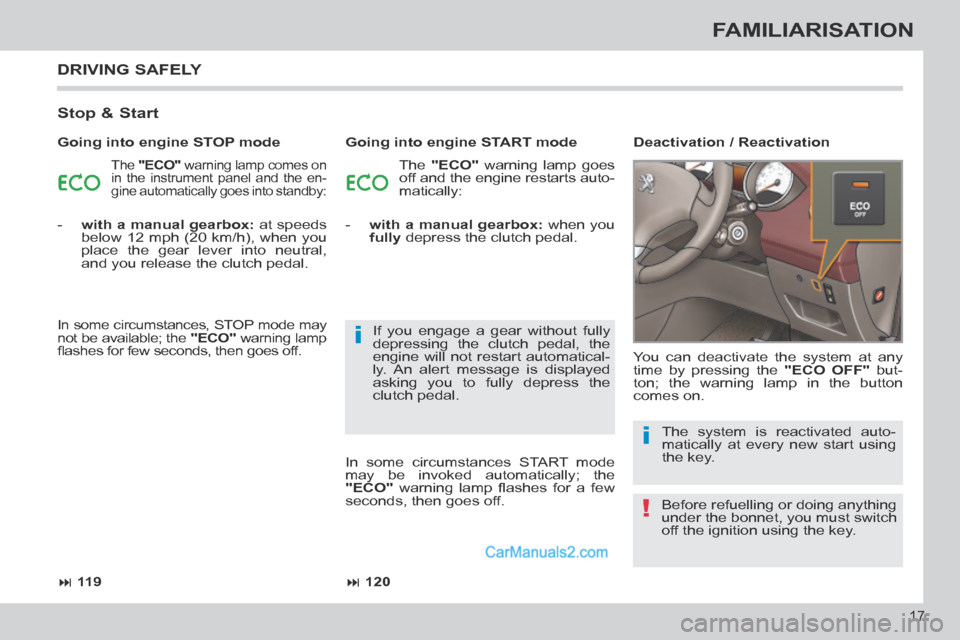
!
i
i
11 9 120
17
FAMILIARISATION
DRIVING SAFELY
Stop & Start
The "ECO" warning lamp comes on
in the instrument panel and the en-
gine automatically goes into standby: The "ECO" warning lamp goes
off and the engine restarts auto-
matically:
You can deactivate the system at any
time by pressing the "ECO OFF" but-
ton; the warning lamp in the button
comes on. Deactivation / Reactivation
Going into engine STOP mode Going into engine START mode
- with a manual gearbox: at speeds below 12 mph (20 km/h), when you
place the gear lever into neutral,
and you release the clutch pedal.
In some circumstances, STOP mode may
not be available; the "ECO" warning lamp
fl ashes for few seconds, then goes off.
- with a manual gearbox: when you fully depress the clutch pedal.
If you engage a gear without fully
depressing the clutch pedal, the
engine will not restart automatical-
ly. An alert message is displayed
asking you to fully depress the
clutch pedal. The system is reactivated auto-
matically at every new start using
the key.
Before refuelling or doing anything
under the bonnet, you must switch
off the ignition using the key.
In some circumstances START mode
may be invoked automatically; the
"ECO" warning lamp fl ashes for a few
seconds, then goes off.
Page 27 of 268
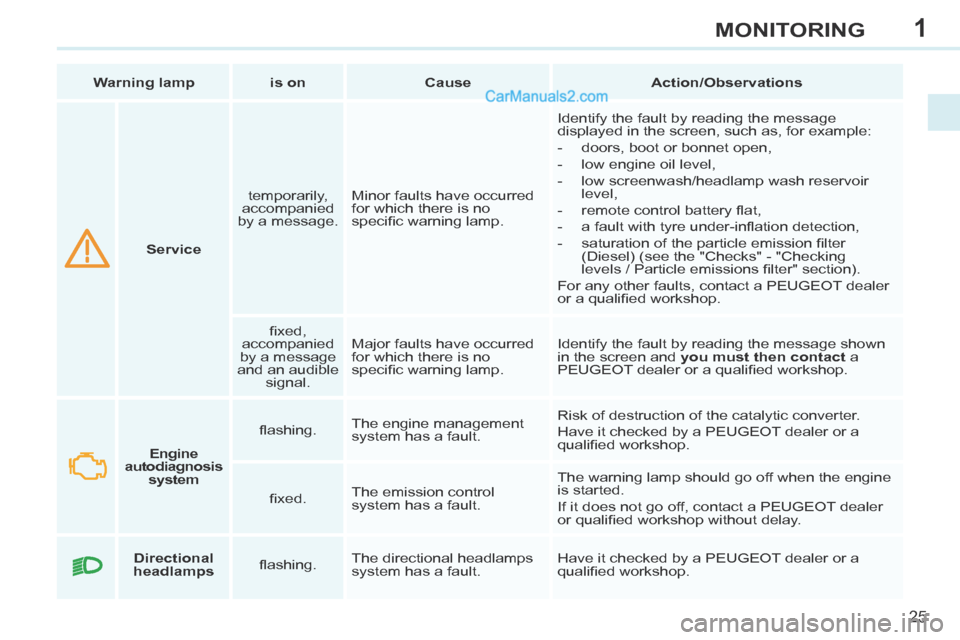
1
25
MONITORING
Service temporarily,
accompanied
by a message. Minor faults have occurred
for which there is no
specifi c warning lamp. Identify the fault by reading the message
displayed in the screen, such as, for example:
- doors, boot or bonnet open,
- low engine oil level,
- low screenwash/headlamp wash reservoir
level,
- remote control battery fl at,
- a fault with tyre under-infl ation detection,
- saturation of the particle emission fi lter (Diesel) (see the "Checks" - "Checking
levels / Particle emissions fi lter" section).
For any other faults, contact a PEUGEOT dealer
or a qualifi ed workshop.
fi xed,
accompanied
by a message
and an audible signal. Major faults have occurred
for which there is no
specifi c warning lamp.
Identify the fault by reading the message shown
in the screen and
you must then contact a
PEUGEOT dealer or a qualifi ed workshop.
Warning lamp
is on Cause Action/Observations
Engine
autodiagnosis system fl ashing.
The engine management
system has a fault. Risk of destruction of the catalytic converter.
Have it checked by a PEUGEOT dealer or a
qualifi ed workshop.
fi xed. The emission control
system has a fault. The warning lamp should go off when the engine
is started.
If it does not go off, contact a PEUGEOT dealer
or qualifi ed workshop without delay.
Directional
headlamps fl ashing. The directional headlamps
system has a fault. Have it checked by a PEUGEOT dealer or a
qualifi ed workshop.
Page 34 of 268
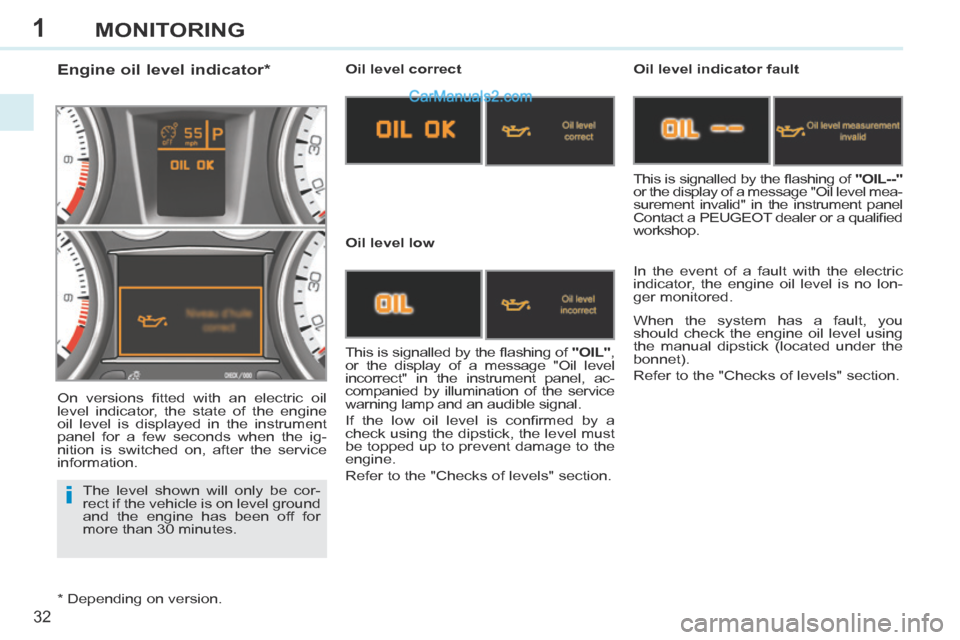
1
i
32
MONITORING
The level shown will only be cor-
rect if the vehicle is on level ground
and the engine has been off for
more than 30 minutes.
Engine oil level indicator * Oil level correct
Oil level low Oil level indicator fault
In the event of a fault with the electric
indicator, the engine oil level is no lon-
ger monitored.
This is signalled by the fl ashing of "OIL" ,
or the display of a message "Oil level
incorrect" in the instrument panel, ac-
companied by illumination of the service
warning lamp and an audible signal.
If the low oil level is confi rmed by a
check using the dipstick, the level must
be topped up to prevent damage to the
engine.
Refer to the "Checks of levels" section. This is signalled by the fl ashing of
"OIL--"
or the display of a message "Oil level mea-
surement invalid" in the instrument panel
Contact a PEUGEOT dealer or a qualifi ed
workshop.
When the system has a fault, you
should check the engine oil level using
the manual dipstick (located under the
bonnet).
Refer to the "Checks of levels" section.
On versions fi tted with an electric oil
level indicator, the state of the engine
oil level is displayed in the instrument
panel for a few seconds when the ig-
nition is switched on, after the service
information.
* Depending on version.
Page 68 of 268
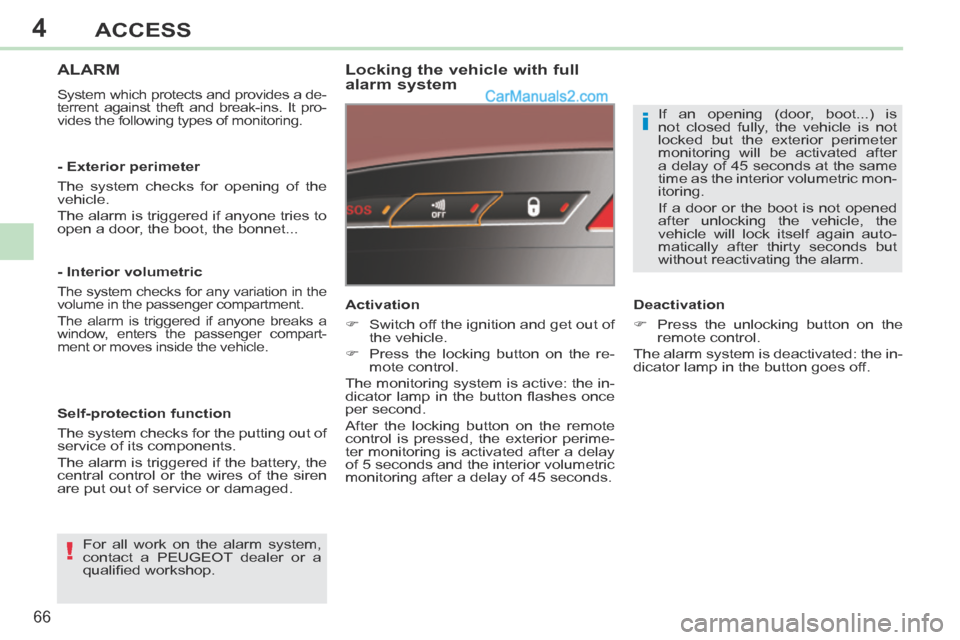
4
!
i
66
ACCESS
ALARM
System which protects and provides a de-
terrent against theft and break-ins. It pro-
vides the following types of monitoring.
Locking the vehicle with full
alarm system
For all work on the alarm system,
contact a PEUGEOT dealer or a
qualifi ed workshop. Activation
Switch off the ignition and get out of
the vehicle.
Press the locking button on the re- mote control.
The monitoring system is active: the in-
dicator lamp in the button fl ashes once
per second.
After the locking button on the remote
control is pressed, the exterior perime-
ter monitoring is activated after a delay
of 5 seconds and the interior volumetric
monitoring after a delay of 45 seconds.
- Exterior perimeter
The system checks for opening of the
vehicle.
The alarm is triggered if anyone tries to
open a door, the boot, the bonnet...
- Interior volumetric
The system checks for any variation in the
volume in the passenger compartment.
The alarm is triggered if anyone breaks a
window, enters the passenger compart-
ment or moves inside the vehicle.
Self-protection function
The system checks for the putting out of
service of its components.
The alarm is triggered if the battery, the
central control or the wires of the siren
are put out of service or damaged.
Deactivation
Press the unlocking button on the
remote control.
The alarm system is deactivated: the in-
dicator lamp in the button goes off. If an opening (door, boot...) is
not closed fully, the vehicle is not
locked but the exterior perimeter
monitoring will be activated after
a delay of 45 seconds at the same
time as the interior volumetric mon-
itoring.
If a door or the boot is not opened
after unlocking the vehicle, the
v ehicle will lock itself again auto-
matically after thirty seconds but
without reactivating the alarm.
Page 123 of 268
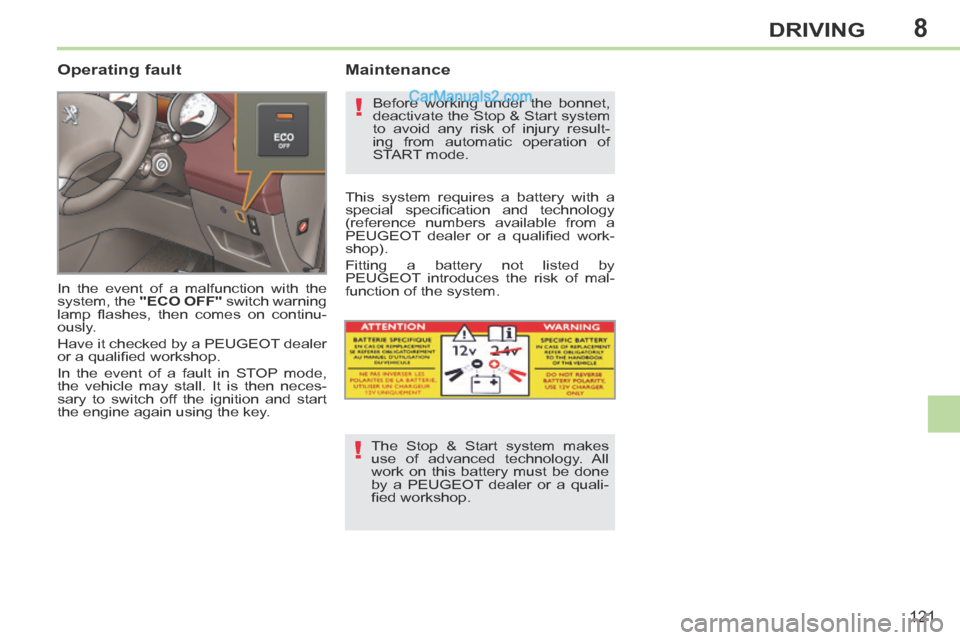
8
!
!
121
DRIVING
Operating fault
In the event of a malfunction with the
system, the "ECO OFF" switch warning
lamp fl ashes, then comes on continu-
ously.
Have it checked by a PEUGEOT dealer
or a qualifi ed workshop.
In the event of a fault in STOP mode,
the vehicle may stall. It is then neces-
sary to switch off the ignition and start
the engine again using the key.
Maintenance
Before working under the bonnet,
deactivate the Stop & Start system
to avoid any risk of injury result-
ing from automatic operation of
START mode.
This system requires a battery with a
special specifi cation and technology
(reference numbers available from a
PEUGEOT dealer or a qualifi ed work-
shop).
Fitting a battery not listed by
PEUGEOT introduces the risk of mal-
function of the system.
The Stop & Start system makes
use of advanced technology. All
work on this battery must be done
by a PEUGEOT dealer or a quali-
fi ed workshop.
Page 133 of 268
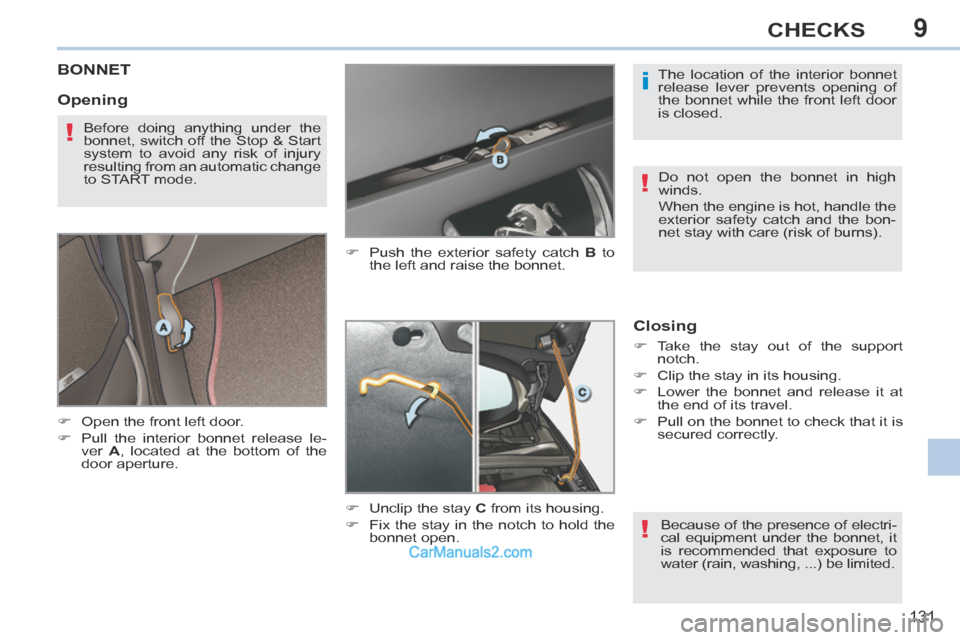
9
i
!
!
!
131
CHECKS
BONNET
Open the front left door.
Pull the interior bonnet release le-ver A , located at the bottom of the
door aperture. Push the exterior safety catch
B to
the left and raise the bonnet.
Closing
Take the stay out of the support notch.
Clip the stay in its housing.
Lower the bonnet and release it at the end of its travel.
Pull on the bonnet to check that it is secured correctly.
Opening
The location of the interior bonnet
release lever prevents opening of
the bonnet while the front left door
is closed.
Do not open the bonnet in high
winds.
When the engine is hot, handle the
exterior safety catch and the bon-
net stay with care (risk of burns).
Before doing anything under the
bonnet, switch off the Stop & Start
system to avoid any risk of injury
resulting from an automatic change
to START mode.
Unclip the stay C from its housing.
Fix the stay in the notch to hold the bonnet open. Because of the presence of electri-
cal equipment under the bonnet, it
is recommended that exposure to
water (rain, washing, ...) be limited.
Page 134 of 268
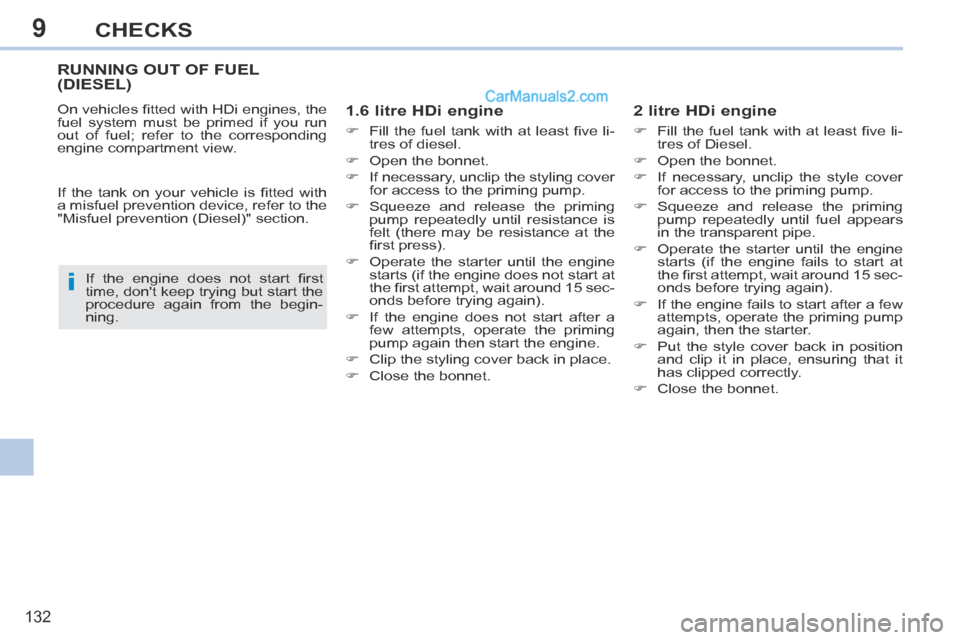
9
i
132
CHECKS
RUNNING OUT OF FUEL (DIESEL)
1.6 litre HDi engine
Fill the fuel tank with at least fi ve li-tres of diesel.
Open the bonnet.
If necessary, unclip the styling cover for access to the priming pump.
Squeeze and release the priming pump repeatedly until resistance is
felt (there may be resistance at the
fi rst press).
Operate the starter until the engine starts (if the engine does not start at
the fi rst attempt, wait around 15 sec-
onds before trying again).
If the engine does not start after a few attempts, operate the priming
pump again then start the engine.
Clip the styling cover back in place.
Close the bonnet.
2 litre HDi engine
Fill the fuel tank with at least fi ve li- tres of Diesel.
Open the bonnet.
If necessary, unclip the style cover for access to the priming pump.
Squeeze and release the priming pump repeatedly until fuel appears
in the transparent pipe.
Operate the starter until the engine starts (if the engine fails to start at
the fi rst attempt, wait around 15 sec-
onds before trying again).
If the engine fails to start after a few attempts, operate the priming pump
again, then the starter.
Put the style cover back in position and clip it in place, ensuring that it
has clipped correctly.
Close the bonnet.
If the engine does not start fi rst
time, don't keep trying but start the
procedure again from the begin-
ning.
On vehicles fi tted with HDi engines, the
fuel system must be primed if you run
out of fuel; refer to the corresponding
engine compartment view.
If the tank on your vehicle is fi tted with
a misfuel prevention device, refer to the
"Misfuel prevention (Diesel)" section.
Page 137 of 268
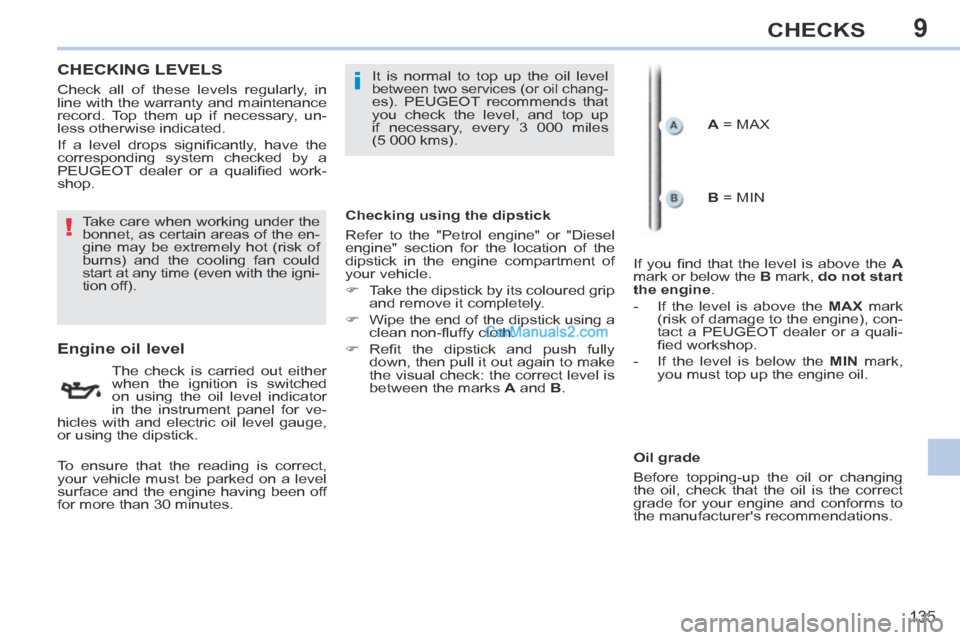
9
!
i
135
CHECKS
CHECKING LEVELS
Engine oil level
The check is carried out either
when the ignition is switched
on using the oil level indicator
in the instrument panel for ve-
hicles with and electric oil level gauge,
or using the dipstick. It is normal to top up the oil level
between two services (or oil chang-es). PEUGEOT recommends that
you check the level, and top up
if necessary, every 3 000 miles
(5 000 kms).
Take care when working under the
bonnet, as certain areas of the en-
gine may be extremely hot (risk of
burns) and the cooling fan could
start at any time (even with the igni-
tion off). A = MAX
To ensure that the reading is correct,
your vehicle must be parked on a level
surface and the engine having been off
for more than 30 minutes. Check all of these levels regularly, in
line with the warranty and maintenance
record. Top them up if necessary, un-
less otherwise indicated.
If a level drops signifi cantly, have the
corresponding system checked by a
PEUGEOT dealer or a qualifi ed work-
shop. Checking using the dipstick
Refer to the "Petrol engine" or "Diesel
engine" section for the location of the
dipstick in the engine compartment of
your vehicle.
Take the dipstick by its coloured grip and remove it completely.
Wipe the end of the dipstick using a clean non-fl uffy cloth.
Refi t the dipstick and push fully down, then pull it out again to make
the visual check: the correct level is
between the marks A and B . B = MIN
If you fi nd that the level is above the A
mark or below the B mark, do not start
the engine .
- If the level is above the MAX mark
(risk of damage to the engine), con-
tact a PEUGEOT dealer or a quali-
fi ed workshop.
- If the level is below the MIN mark,
you must top up the engine oil.
Oil grade
Before topping-up the oil or changing
the oil, check that the oil is the correct
grade for your engine and conforms to
the manufacturer's recommendations.